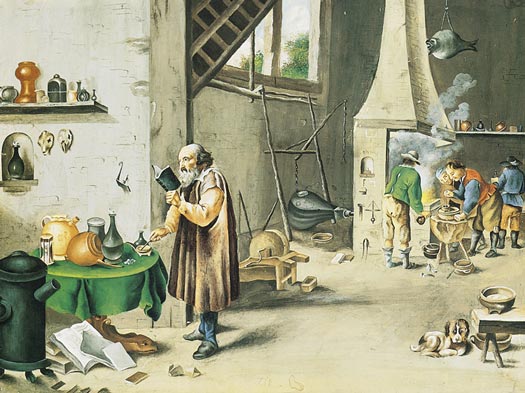
This Article From Issue
May-June 2001
Volume 89, Number 3
DOI: 10.1511/2001.22.0
A Chemical History Tour: Picturing Chemistry from Alchemy to Modern Molecular Science. Arthur Greenberg. xx + 312 pp. John Wiley and Sons, 2000. $59.95.
A book warmly recommended by the likes of Roald Hoffmann and Oliver Sacks is sure to attract the interest of chemists. These recommendations are justified: A Chemical History Tour is a "magical mystery tour" through the history of chemistry, tracing its development from "practical, medical and mystical roots" to its current incarnation as a molecular science. This is not an encyclopedic work on the entire history of the science, but a picture book to be read and enjoyed by chemists and nonchemists alike. Nevertheless, it will serve as a valuable secondary source for historians of science, since it refers to many important scholarly works treating the history of chemistry.

From A Chemical History Tour.
The book is composed of a series of brief essays concerning 160-odd pictures taken from an astonishing variety of chemical and alchemical treatises, papers and manuscripts, arranged in roughly chronological order. The author's style is conversational, and the book is liberally sprinkled with his droll humor, some of which will resonate only with synthetic chemists. For example, when discussing a plate depicting a pair of alchemists kneeling before their laboratory furnace, he writes, "Any chemist who has tried a new reaction will appreciate the prayerful aspect of this picture." Amen. I might add that some of the puns, which I leave for the reader to discover, are truly dreadful.
There is much useful alchemical information here, even a truly marvelous formula for synthesizing the Philosopher's Stone—which this review is not large enough to contain. However, if you are ever plagued by anonymous passersby defecating at your doorstep, try the solution of 17th-century alchemist Johann Baptist Van Helmont:
Hath any one with his excrements defiled the threshold of thy door, and thou intendest to prohibit that nastiness for the future, do but lay a red-hot iron upon the excrement, and the immodest sloven shall, in a very short space, grow scabby on his buttocks, the fire torrifying the excrement, and by dorsal magnetism driving the acrimony of the burning, into his impudent anus.
Thus one learns that the ancient alchemists were not fixated on obtaining the Philosopher's Stone but were also concerned with practical matters such as metallurgy, medicine and, ah, public sanitation. The pictures and descriptions of chemistry as it was practiced in bygone ages make one truly appreciate the ready availability today of high-purity chemicals and high-quality laboratory apparatus. Who wouldn't be fervently thankful not to have to heat their chemical reactions in a bath of steamed boar dung?
The author deftly maneuvers through the history of phlogiston theory, atomic theory, the periodic table, thermodynamics (caloric theory), the ideal gas law, organic chemistry, radioactivity and the understanding of chemical bonding, among other topics, providing vignettes of the lives of many eminent chemists in the course of his narrative. He even weaves in a few multicultural elements, such as a brief essay on Catawba Indian pottery; however, these left me cold. A more detailed discussion of the discovery of gunpowder by the Chinese would have been more interesting. The topics were chosen idiosyncratically, but the major facets of chemistry's development are all here. There are some repetitions from essay to essay, and a few scattered typos, but these do not detract materially from the overall value of the book. As another successful popularizer of science, P. W. Atkins, wrote in the preface to his Molecules, "There is no particular order in which the book should be read; indeed it is not necessarily meant to be read in any order: It is a book for occasional delectation." Bon appétit!—Tim Royappa, Chemistry, University of West Florida, Pensacola
American Scientist Comments and Discussion
To discuss our articles or comment on them, please share them and tag American Scientist on social media platforms. Here are links to our profiles on Twitter, Facebook, and LinkedIn.
If we re-share your post, we will moderate comments/discussion following our comments policy.